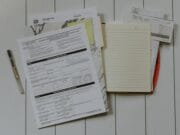Have you ever thought about what plagiarism means or why it is considered a huge problem? Plagiarism is the practice of taking someone else’s words, ideas, images, or creations and passing them off as one’s own work. It can happen in many different contexts. For example, it’s common for students to plagiarize their term papers or dissertations in school. But it can also occur in the workplace or in professional situations, such as when an artist creates a piece based on existing designs or someone copies original characters from a TV show or book.
Unfortunately, plagiarism happens more often than it should. It can occur unintentionally or because the writer didn’t properly cite their work. Despite differences in intent and outcome, plagiarism comes from copying someone else’s work without giving them proper credit.
The following is the list of actions considered plagiarism:
Image source: Thing Link.
- Copying words/ideas/thoughts from someone else without giving proper credit: Even if you don’t copy exactly but rather re-write the information in your own words, it is still necessary to credit the original source.
- Presenting someone else’s work as your own: This is the simplest and most common form of plagiarism. You are plagiarizing if you purchase, borrow, or steal an assignment and submit it as your own work.
- Failing to quote: If you use another person’s words directly in your paper, you must enclose the words in quotation marks. You also need to include a citation.
- To present an existing idea and thought as new information: Presenting a paper with minimal or no new information and copying existing ideas to write a brand new paper comes under plagiarism. Making up the majority of your work by using copied ideas is plagiarizing.
- Providing wrong information about the source: If you use a direct quote from another source, make sure to include the author’s name and date of publication in your citation. When you do not provide this detail, you are not citing correctly, and therefore, it is considered plagiarism. It also applies when using paraphrased ideas and information from another source. So, ensure you cite as you write.
Recommended for you: 8 Common Queries with Answers That Briefly Describe Content Plagiarism.
Types of Plagiarism
Image source: Analytic Steps.
There are various types of plagiarism. They include:
- Direct or Global Plagiarism: In Global or Direct plagiarism, the words are copied word-for-word from another source without citing the author or including quotation marks. It involves copying and pasting the entire original work without any changes except the author’s name. It is the most used form of plagiarism in the academic industry.
- Patch or Mosaic Plagiarism: Mosaic plagiarism can be tricky to identify. It involves the attempt to disguise the original source by simply copying a series of sentences or paragraphs lifted straight from the source without using quotation marks or by using similar words while writing the original quote of the author.
- Self-Plagiarism: Self-plagiarism is a common problem that occurs when students submit their own previous work from previous courses without the professor’s permission. However, remember that it can also happen when a student submits the same paper to multiple classes. Students may submit work projects or assignments for a course in addition to writing a final project for the same class.
- Accidental plagiarism: Plagiarism isn’t always meant to be malicious, and it isn’t always done consciously or purposefully. It might ensue carelessly out of ignorance or unawareness. But even if the omission or incorrect citation was accidental, it’s still considered plagiarism, and it can happen to writers who just don’t know better.
How To Avoid Plagiarism?
Image source: eLearners.
To avoid plagiarism, the initial step is to understand it properly. Now, since we steer clear of that, let’s explore ways to prevent it.
1. Create an Original Idea:

To eradicate the potential of plagiarism, the most effective method is to present an original idea. First, ensure that the following idea has not already been published elsewhere. Good research takes time — a LOT of time. Executing your research well in advance allows you to spot errors and avoid bad decisions, thereby helping you perform better in your paper. Take the maximum time to develop your ideas and perspective on the subject. After all, no work is as good as an original one!
2. Track and Cite your Sources:

It is not every day that you find an exquisite idea that is completely original. You might find a similar notion that a different author has already published. It is not unethical to use that in your research. However, it is unethical not to cite and appropriately credit the original author. Thus, you mustn’t copy anyone’s words, ideas, or phrases when writing your papers. Even if you reword what others have written, you need to cite these as your information sources. When you choose to use others’ words or ideas, it is necessary to cite them in the required format.
3. Quotations:

One of the most common ways to avoid plagiarism is by inserting quotes around a direct quote. It indicates that the words aren’t your own and that you are paying credit where credit is due (and not stealing someone else’s words). Quotation marks (““) surround written material directly copied from a source. Indirect or paraphrased quotes are not put in quotation marks.
According to the Merriam-Webster dictionary, a quote is:
- To repeat (something written or said by another person) exactly.
- To write or say the exact words of (someone).
For instance,
“All the world’s a stage, and all the men and women merely players. They have their exits and their entrances, and one man in his time plays many parts.” — Shakespeare, As You Like It, Act 2, Scene 7.
4. Good Paraphrasing:

Paraphrasing is repeating something in different words and wording. There may be multiple ways and methods to write a paraphrase, including changing the length of the prose, changing the sentence structure, etc.
For example:
Original: This is the most famous brand among all and is preferred by many influencers.
Paraphrased: The following brand is the most prominent and is loved by the majority of influential people.
Paraphrasing is like riding a bike; it feels simple and easy to do. But, on the other hand, plagiarizing is like biking head-first into a brick wall. It hurts! And could hurt your academic career. So, to paraphrase with confidence, cite your sources.
5. Summarizing:

Summary writing is a kind of writing in which the writer condenses or reduces the detail or length of a larger text. In other words, you take longer articles and trim them by removing some details without disrupting the actual meaning of the content.
For example:
Original: The Amphibians, which is the animal class our frogs belong to, were the first animals to crawl and come onto the land to live.
Summarized: The amphibians were the first species to leave the sea and live on the land.
You may like: Tools & Tips to Deal with your Stolen Content (Plagiarism).
6. Employ Plagiarism Checking Tools:

Plagiarism checkers (tools) are pretty popular for a good reason. If you’ve never used a plagiarism checking tool before, you might be wondering what all the fuss is about. In short, these tools can accurately check an enormous number of websites for any instances of your work that you may have copied without attribution and catch them before you submit your work.
They’re essential because they can help you create original content that stands out among all the other articles online. Some prominent plagiarism checkers are Grammarly, Copyscape, and Turnitin. It is always advisable to check your plagiarism percentage before submitting your work.
Consequences of Plagiarism

Image source: Pubrica.
Plagiarism is a considerable violation in academia. It can lead to professional, legal as well as ethical consequences.
In Academic Institutions:

Plagiarism is one of the most severe offenses in academic institutions. Some students might not understand its gravity and continue plagiarising their academic papers and assignments flagrantly. Suppose you’re caught plagiarizing or turning in the work of another student or professional. In that case, you can face consequences as severe as expulsion from school, suspension, and failure of the course. It harshly affects and damages one’s reputation.
“Students who plagiarize or otherwise engage in academic dishonesty face serious consequences. Sanctions may include, but are not limited to, failure on an assignment, grade reduction or course failure, suspension, and possibly dismissal,” says Bowdoin University.
In Academia and Research:

It’s an issue that many academic researchers encounter, and one that can have serious personal, financial and professional consequences for those accused of plagiarizing another individual’s work. The most apparent impact of plagiarism is the damage to a researcher’s reputation. The consequences are not limited to revocation of degree if your dissertation/thesis is plagiarized, loss of funding, loss of work status, and legal actions as well.
“Where an article, for example, is found to have plagiarized other work or included third-party copyright material without permission or with insufficient acknowledgment, or where the authorship of the article is contested, we reserve the right to take action including, but not limited to publishing an erratum or corrigendum (correction); retracting the article; taking up the matter with the head of department or dean of the author’s institution and/or relevant academic bodies or societies, or taking appropriate legal action,” quotes SAGE publications.
You can learn the consequences of plagiarism in a broader spectrum here.
What are the legal and monetary repercussions?

Writing is not a simple task. It requires skill, practice, and dedication to create content that grabs readers’ attention. No one wants their hard-earned articles and books to be copied without attribution. An author has all the rights to sue the plagiarist on the grounds of copyright infringement. Many people don’t know about the legal repercussions of plagiarism or the details of copyright law. It is a literary breach and, in some cases, considered a criminal offense that can lead to a prison sentence.
Another consequence can be in terms of monetary compensation. Michael Bolton, the singer, was also sued for plagiarism. The Love Is A Wonderful Thing song that he is most famous for was striking similarities with the Isley Brothers’ song. As a result, Bolton and Andrew Goldmark, his coauthor, was ordered by the jury to pay $5.4 million in damages for copyright infringement.
You may also like: Brand Protection in 2022: Tools, Web Scrapers & Proxies.
Summing it up

Ultimately, plagiarism is wrong. It’s theft and should never be tolerated. However, by researching what it is, you’ll be better equipped to avoid it as a writer. Whether you choose to write as your profession or cultivate it as a hobby, getting your facts straight and accurate citing ensures you don’t get in trouble over simple or minute things.
This article is written by Kanu Priya. Kanu is from Typeset and is an avid reader and enthusiastic writer. She has written several other blogs in the niche of academia and research. Intrigued by marketing and the digital world, she has a keen interest in content marketing and learns new things every day. You can follow her on LinkedIn.








